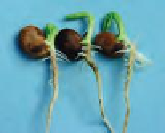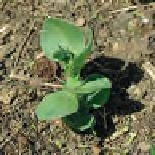Agriculture Reference
In-Depth Information
Growth and development
Like people, plants follow a series of distinct phases in
their lives, described as the plant's 'life cycle'. Unlike
humans, the plant life cycle can be either very short,
a matter of weeks in ephemerals such as
Senecio
vulgaris
(groundsel) or many thousands of years as in
Pinus aristata
(the bristlecone pine), some individuals
of which are thought to be more than 5,000 years old.
In most cases, a plant's life begins with fertilization
and the development of the embryo within a
seed
.
Germination of the seed gives rise to a seedling
which undergoes a
juvenile
period of growth and
development. On reaching
adulthood
, the plant is
able to reproduce, then having produced fruits and
seeds, a period of
senescence
ending in
death
of the
plant ensues (Figure 5.2).
The changes that take place in the structure, form and
behaviour of a plant through its life cycle can usefully
be described as '
plant development
'. This is in
contrast to the term '
plant growth
',
which refers to
the increase in a plant's weight and size. Plant growth
is brought about in two ways:
X
by new cells being produced in the meristems (see
p. 78)
X
the new cells expanding due to turgor pressure
(see p. 120).
The production of new cells is fuelled by the
processes of photosynthesis, respiration and mineral
uptake (see Chapters 9 and 10).
The typical life cycle of plants, from seed to death, and
some of the horticultural implications for each phase
are described in this chapter.
Plant growth
is the increase in size of cells,
organs or the whole plant due to cell division
and cell expansion.
Plant development
describes the changes in structure, form and
behavior through its life cycle.
The seed
Following fertilization the seed represents the first
stage of the plant's life cycle. Seeds contain and protect
the plant embryo, which will grow into the new plant,
and a food store which will support growth until the
plant is able to photosynthesize and manufacture its
own food supply. A seed enables the plant to withstand
periods when the environment is not suitable for
growth and may have mechanisms which bring about
seed dormancy. It is also the means by which plants
spread away from the parent plant, and colonize new
areas thereby reducing competition for water and
nutrients and increasing the success of survival of the
species. Seed structure is described in Chapter 8.
Seed viability
Death
Seed
A
viable
seed has the potential for germination when
the required external conditions are supplied. Its
viability is, therefore, an indication of whether the
seed is 'alive' or not. Most seeds remain viable until
the next growing season but many can remain so for
a number of years until conditions are favourable for
germination. In general, viability of a batch of seed
diminishes with time, its maximum viability period
depending largely on the species. For example, celery
seed quickly loses viability after the first season, but
wheat has been reported to germinate after scores of
years. The germination potential of any seed batch will
depend on the storage conditions of the seed, which
should be cool and dry, slowing down respiration.
Some seeds, described as 'orthodox' seeds, can be
stored successfully for long periods in these conditions
while other 'recalcitrant' seeds lose viability quickly and
require more specialist treatment (see p. 129). Cool,
dry conditions are achieved in commercial seed stores
by means of sensitive control equipment. Packaging of
seed for sale takes account of these requirements and
often includes a waterproof lining of the packet, which
Juvenile
rapid
vegetative
growth
Senescence
growth
ceases
Adult
reproductive
growth -
flowers, fruits
and seeds
Figure 5.2
Stages in the life cycle of
Vicia faba
(broad
bean)











